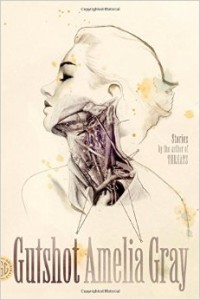Gutshot by Amelia Gray
224 pages, $14.00, Paperback
REVIEW BY T.M. SUMNER
Amelia Gray is a mortician with an overactive imagination. Gutshot, her fourth publication, is an unflinchingly gory examination of life and the human interior told through stories and flashes that go for the gross out. Gray dissects human anatomy and the human spirit: blood, severed appendages, and mucus. Her stories extract the weird darker side of society—violence, vileness, longing, and despair. She punches us with a reading experience that is at times surrealist, absurd, or, on occasion, sentimental. This work is a complement to her three previous publications of oddities: AM/PM, Museum of the Weird, and Threats.
Gutshot is divided into five sections that vary in theme and influence, but they connect through Gray’s unmistakable style. She draws from literary fiction, horror, surrealism, romance, fabulism, thriller, and science fiction, often breaking from traditional storytelling altogether. She pulls in readers while pushing them into unfamiliar environments that inspire feelings of confusion and conflict. Her prose is punctuated by micro-epiphanies that challenge us to consider what we’re made of—emotionally and biologically: “Your heart is a wall of the same brick repeated,” she writes in “Loop.” She questions what we’ll leave behind when we die: “Every body of work deserves its spoils. When we keepers go, we’ll get maps and plans and cenotaphs in miniature, all housed deep under slabs bearing the names of every man, woman, and blue-faced baby we drew down, a towering monument to our work,” she writes in “Legacy.” She examines what interior and exterior spaces haunt us: “Our home was once the preparation wing of a garment factory, in which material was boiled with chemicals to change its color and character,” she writes in “House Heart.”
Gray’s writing possesses an intimate quality. Yet like the accouterment—spatulas, incision spreaders, mirrors, embalming fluid, an absorbed twin—resting on a mortician’s tray, it also hints at the grotesque. Her prose is brutal and bizarre. It incorporates unusual images. A whale’s heart. Crowbar. Swan poop. A Dunkin Donut’s in flames. Benzoyl peroxide. Scorched plastic. She utilizes the mundane to call attention to apparatuses we often overlook: “Every problem in the world can be traced to attention or its lack,” she writes in “Loop.”
Most of her characters would make nightmarish neighbors (unless you want to live next door to the Klopeks from the Tom Hanks’ movie The ‘Burbs). They rent a young woman and lock her in an air-conditioner intake duct, develop chronic puking problems, become cannibals, mutilate, castrate, and devise strategies for killing their boyfriends. But her freakishness is tongue-in-cheek and balanced with humor and heart. For instance, in “Date Night,” a couple goes to dinner and begins physically ripping their bodies apart: “Another man flicks open his button fly. His public hair scatters like dandelion florets. The man howls and a woman rips his dick off and drops it into a bowl of soup. What’s the deal with soup!” While Gray may be the queen of differentiation, here she points to a universal if not familiar theme: what it means to be alive. The mutilation isn’t an incursion; it is a celebration of humankind. She writes, “Every piece of internal armor on each individual is so thick with shine that even light from the recent past and future finds a way to burst forth, shattering across shattering glass, covering all in a blinding healing bleeding screaming LIGHT because that’s what LIFE is, you assholes! That’s what it means to be alive!” Her words remind us that the human body is a casing similar to a beetle’s shell. Inside, we’re soft.
Gutshot’s heavy-handedness is both its shortcoming and its strength. Gray tries—with great success—to be different and deliver what no one else has said. Underneath her eerie, original imagery and sentences, she explores ubiquitous themes: relationships, love, death, and life. The heart is a central image to her work, as is the house. She is a mortician who spends time with the dead, but her job doesn’t depress her. No, no. It makes her more alive. Lucky for us, she’s brought to the page her secret, which is hard to succinctly write but I’ll give it a try: To live without ghosts is not to live at all. Tell me, what will you do with the rest of your life?
T.M. Sumner is a freelance writer and the managing editor of Rathalla Review. She is an MFA candidate at Rosemont College, where she is writing her first novel. She holds a MS in Publishing from NYU and a BA in English from VCU.
![[PANK]](https://pankmagazine.com/wp-content/themes/pank/assets/images/pank-logo-large.png)

